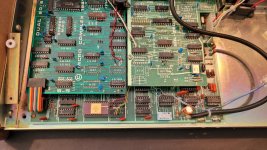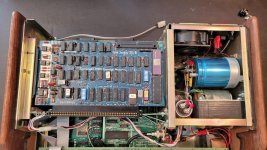Hello,
I'm new member on this forum. I joined after doing a bit of research on the Sol-20. I found this to be the most 'active' site for the Sol with 9 unique members posting this year on a few related topics. I guess that's not bad for a 40+ yr old computer.
A bit of history.... I built a Sol-20 from a kit circa 1976/77 timeframe - shortly after it was made available. I was active in helping to form a SOLUS club in Denver in the late 70s. After numerous upgrades/mods and additional subsystems to the original machine over the years, I continued to enjoy its usefulness. My first printer was an old ASR-35? I believe. I then went on to an early dot-matrix printer, and later a RS Daisy-wheel printer. Sadly, my Sol gradually got replaced with newer computers coming on the market. In the late 80s it got boxed up and put in storage for more years than I care to admit. But I always insisted on keeping it and I did.
Just recently I was contacted via the web from a gentleman needing some physical measurements of the Sol. I was more than eager to help out. So, after several moves across the country, that box that was so securely taped up got opened! Out came my Sol. Still looking as good as ever. Brought back a lot of great memories and local associations I had made because of it.
Now for the really sad part.... Even though I had kept the Sol, over the years the 2 disk subsystems I had used with it, a North* MDS, and a dual 8" floppy system (not the Helios), got discarded thinking I would never use the Sol again. In retrospect, a bad choice. In addition, all my documentation, notes, user manuals, newsletters and all software got mistakenly thrown out while I was away on a 2 week assignment. This was not apparent until a few months later when I went searching for some of it.
So now.... I have a Sol that's in very, very good shape aside from being 46 yrs old that was packed well, and kept away from extreme heat and humidity over those years. And no peripheral gear to make it work. I knew of one major upgrade I had done where I installed a mod that increased the video output to 24 lines x 80 characters. However, when I opened it up, I noticed a couple other mods I had made and forgotten about. One was a Z80 CPU mod board, and a small pcb under the keyboard. Not sure what that did. I had also added the xformer/bridge rectifier upgrade to help stabilize the mains voltage? I also noticed the 3, S-100 boards I was using; (1) a 64k RAM board, (2) a George Morrow Disk Jockey 2D/B board, and (3) a Micro Complex, Phase Lock II Dual Density Controller board. Can't remember why there were two controller boards, or if I was using both, or not. Oh, the SOLOS module is also a custom one from Micro Complex. It switches from two different address configuration, C000 and It did some special things with the video mod as well as compatibility with the Phase Lock II controller I believe? But my memory of what did what is very sketchy.
Anyway, what to do now....?
I haven't tried powering it up yet. I read in one of the Sol related threads, that after 40 years all Tantalum capacitors should be replaced? Really? I knew of Electrolytics, but not Tantalums. Can someone confirm. With the way the video and Z80 mod boards attach to the motherboard(via header pins on the bottom that insert into IC sockets), that will be an undertaking I'm not sure I'm ready to do. What's the real risk of not replacing the tants?
Furthermore, without a disk subsystem in place and proper boot disk, it's unlikely that anything will show up on a screen, much less boot. Without my old, old notes, I have no frame of reference of what I had to do to boot it up anymore and no equipment to do it with!
Are original North* boot disks for the Sol still available? I do have a single 5.25 disk drive that may be useable that's boxed up with my Slicer. Not sure what brand it was. It was half-height though. But still no disks. From reading here, I would use the VSG dongle?
After unearthing my Sol, I've spent countless hours visiting & logging useful related sites, downloading software, printing out parts of the SOL-20 Systems Manual, other user guides from products I have and newsletters, etc. IOW, trying to prepare myself for getting this ole machine running again. However, it's just one of many projects on my retired plate now.
Any advice, observations, suggestions, tips and tricks, new things to use, to get it back up and running would be appreciated from the active members on vcfed.org. Here are a few inside pics;
Rick




I'm new member on this forum. I joined after doing a bit of research on the Sol-20. I found this to be the most 'active' site for the Sol with 9 unique members posting this year on a few related topics. I guess that's not bad for a 40+ yr old computer.
A bit of history.... I built a Sol-20 from a kit circa 1976/77 timeframe - shortly after it was made available. I was active in helping to form a SOLUS club in Denver in the late 70s. After numerous upgrades/mods and additional subsystems to the original machine over the years, I continued to enjoy its usefulness. My first printer was an old ASR-35? I believe. I then went on to an early dot-matrix printer, and later a RS Daisy-wheel printer. Sadly, my Sol gradually got replaced with newer computers coming on the market. In the late 80s it got boxed up and put in storage for more years than I care to admit. But I always insisted on keeping it and I did.
Just recently I was contacted via the web from a gentleman needing some physical measurements of the Sol. I was more than eager to help out. So, after several moves across the country, that box that was so securely taped up got opened! Out came my Sol. Still looking as good as ever. Brought back a lot of great memories and local associations I had made because of it.
Now for the really sad part.... Even though I had kept the Sol, over the years the 2 disk subsystems I had used with it, a North* MDS, and a dual 8" floppy system (not the Helios), got discarded thinking I would never use the Sol again. In retrospect, a bad choice. In addition, all my documentation, notes, user manuals, newsletters and all software got mistakenly thrown out while I was away on a 2 week assignment. This was not apparent until a few months later when I went searching for some of it.
So now.... I have a Sol that's in very, very good shape aside from being 46 yrs old that was packed well, and kept away from extreme heat and humidity over those years. And no peripheral gear to make it work. I knew of one major upgrade I had done where I installed a mod that increased the video output to 24 lines x 80 characters. However, when I opened it up, I noticed a couple other mods I had made and forgotten about. One was a Z80 CPU mod board, and a small pcb under the keyboard. Not sure what that did. I had also added the xformer/bridge rectifier upgrade to help stabilize the mains voltage? I also noticed the 3, S-100 boards I was using; (1) a 64k RAM board, (2) a George Morrow Disk Jockey 2D/B board, and (3) a Micro Complex, Phase Lock II Dual Density Controller board. Can't remember why there were two controller boards, or if I was using both, or not. Oh, the SOLOS module is also a custom one from Micro Complex. It switches from two different address configuration, C000 and It did some special things with the video mod as well as compatibility with the Phase Lock II controller I believe? But my memory of what did what is very sketchy.
Anyway, what to do now....?
I haven't tried powering it up yet. I read in one of the Sol related threads, that after 40 years all Tantalum capacitors should be replaced? Really? I knew of Electrolytics, but not Tantalums. Can someone confirm. With the way the video and Z80 mod boards attach to the motherboard(via header pins on the bottom that insert into IC sockets), that will be an undertaking I'm not sure I'm ready to do. What's the real risk of not replacing the tants?
Furthermore, without a disk subsystem in place and proper boot disk, it's unlikely that anything will show up on a screen, much less boot. Without my old, old notes, I have no frame of reference of what I had to do to boot it up anymore and no equipment to do it with!
Are original North* boot disks for the Sol still available? I do have a single 5.25 disk drive that may be useable that's boxed up with my Slicer. Not sure what brand it was. It was half-height though. But still no disks. From reading here, I would use the VSG dongle?
After unearthing my Sol, I've spent countless hours visiting & logging useful related sites, downloading software, printing out parts of the SOL-20 Systems Manual, other user guides from products I have and newsletters, etc. IOW, trying to prepare myself for getting this ole machine running again. However, it's just one of many projects on my retired plate now.
Any advice, observations, suggestions, tips and tricks, new things to use, to get it back up and running would be appreciated from the active members on vcfed.org. Here are a few inside pics;
Rick




